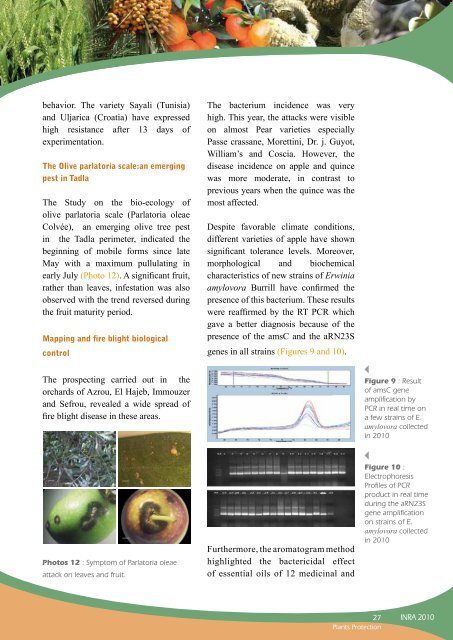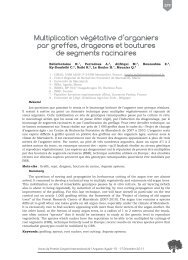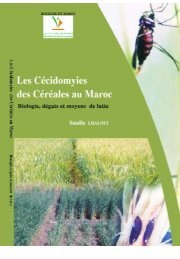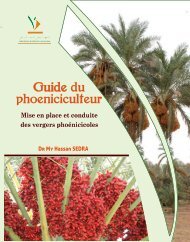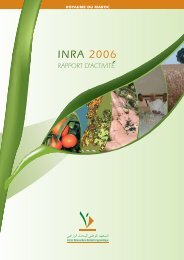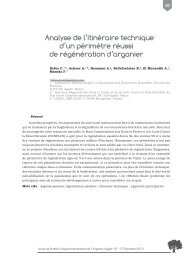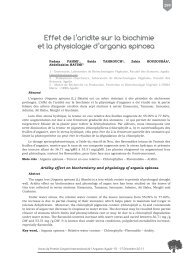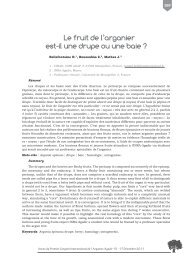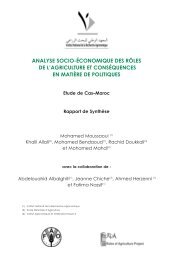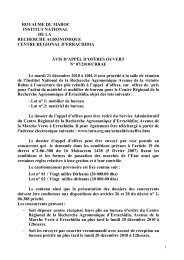varieties creation and conservation of plant genetic resources
varieties creation and conservation of plant genetic resources
varieties creation and conservation of plant genetic resources
Create successful ePaper yourself
Turn your PDF publications into a flip-book with our unique Google optimized e-Paper software.
ehavior. The variety Sayali (Tunisia)<br />
<strong>and</strong> Uljarica (Croatia) have expressed<br />
high resistance after 13 days <strong>of</strong><br />
experimentation.<br />
The Olive parlatoria scale:an emerging<br />
pest in Tadla<br />
The Study on the bio-ecology <strong>of</strong><br />
olive parlatoria scale (Parlatoria oleae<br />
Colvée), an emerging olive tree pest<br />
in the Tadla perimeter, indicated the<br />
beginning <strong>of</strong> mobile forms since late<br />
May with a maximum pullulating in<br />
early July (Photo 12). A significant fruit,<br />
rather than leaves, infestation was also<br />
observed with the trend reversed during<br />
the fruit maturity period.<br />
Mapping <strong>and</strong> fire blight biological<br />
control<br />
The prospecting carried out in the<br />
orchards <strong>of</strong> Azrou, El Hajeb, Immouzer<br />
<strong>and</strong> Sefrou, revealed a wide spread <strong>of</strong><br />
fire blight disease in these areas.<br />
Photos 12 : Symptom <strong>of</strong> Parlatoria oleae<br />
attack on leaves <strong>and</strong> fruit.<br />
The bacterium incidence was very<br />
high. This year, the attacks were visible<br />
on almost Pear <strong>varieties</strong> especially<br />
Passe crassane, Morettini, Dr. j. Guyot,<br />
William’s <strong>and</strong> Coscia. However, the<br />
disease incidence on apple <strong>and</strong> quince<br />
was more moderate, in contrast to<br />
previous years when the quince was the<br />
most affected.<br />
Despite favorable climate conditions,<br />
different <strong>varieties</strong> <strong>of</strong> apple have shown<br />
significant tolerance levels. Moreover,<br />
morphological <strong>and</strong> biochemical<br />
characteristics <strong>of</strong> new strains <strong>of</strong> Erwinia<br />
amylovora Burrill have confirmed the<br />
presence <strong>of</strong> this bacterium. These results<br />
were reaffirmed by the RT PCR which<br />
gave a better diagnosis because <strong>of</strong> the<br />
presence <strong>of</strong> the amsC <strong>and</strong> the aRN23S<br />
genes in all strains (Figures 9 <strong>and</strong> 10).<br />
Furthermore, the aromatogram method<br />
highlighted the bactericidal effect<br />
<strong>of</strong> essential oils <strong>of</strong> 12 medicinal <strong>and</strong><br />
Figure 9 : Result<br />
<strong>of</strong> amsC gene<br />
amplification by<br />
PCR in real time on<br />
a few strains <strong>of</strong> E.<br />
amylovora collected<br />
in 2010<br />
Figure 10 :<br />
Electrophoresis<br />
Pr<strong>of</strong>iles <strong>of</strong> PCR<br />
product in real time<br />
during the aRN23S<br />
gene amplification<br />
on strains <strong>of</strong> E.<br />
amylovora collected<br />
in 2010<br />
27 INRA 2010<br />
Plants Protection


